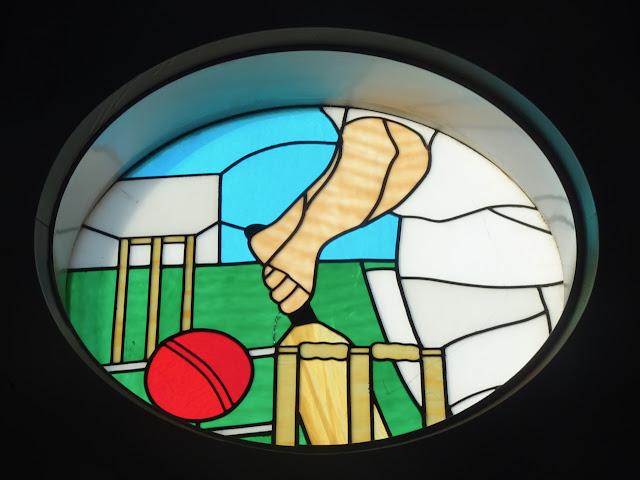Here is the 23rd of 24 stained glass window designs on the Palace Pier which AI and I are using as inspiration for some of these BrightonBeach365 daily posts - see Stained Glass Window 1 for background. This image shows a circular scene of rolling countryside rendered in bold, simplified shapes. Sweeping green hills overlap in layered bands, with deeper greens suggesting shaded folds in the land. Brighter yellow paths or fields cut diagonally through the slopes, adding movement and contrast. Above the landscape, large billowing clouds stretch across a clear, bright sky, their rounded forms outlined in dark contours. The whole composition has a stylised, almost mosaic-like quality giving the landscape a rhythmic, patterned feel.
A limerick starter
A rambler set out with great pride
Across hills rolling green, far and wide;
But each curving bright track
Led him cleanly off track -
Now he’s still in those fields, trying to decide.
Innocent circle? (after Thomas Pynchon)
On a Tuesday of no particular consequence - though the gulls claimed otherwise - Vasco found a circular picture half-buried in Brighton’s shingle, its colours too bright for English weather, its hills too neatly curved to be trusted. The thing gave off the faint chemical optimism of a 1970s educational poster, the sort issued by governments hoping children might one day become engineers instead of anarchists.
He picked it up. Warm. Suspiciously warm.
A woman in an orange raincoat, passing at speed as if pursued by minor debts, shouted, Don’t look at it directly! Then she vanished behind a windbreak plastered with QR codes and promotional offers which, if decoded, might or might not summon a free ice cream. Farther along the beach, a group of students were conducting what they called ‘an unauthorised topographical intervention’, which mostly involved pointing surveyor rods at the Palace Pier and arguing about the metaphysics of load-bearing structures.
Vasco had the distinct impression that the picture in his hand - this innocent circle of rolling hills and friendly clouds - was part of a much larger operation, though whether artistic, military, or merely bureaucratic he couldn’t yet tell. Brighton had always been like this: sunlit afternoons perforated by intrigue. Even the pebbles seemed to be signalling to one another, clicking out messages in some forgotten coastal Morse.
He turned the picture over. Nothing on the back but a faint smell of ozone and custard cream. Classic misdirection.
Somewhere beyond the West Pier’s skeletal remains, a low hum gathered - something between distant surf and an idling generator. Vasco couldn’t be sure, but it seemed the landscape in the picture was beginning, imperceptibly, to move.

























